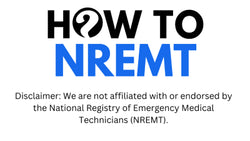As the NREMT exam evolves to reflect real-world EMS practice, one of the most notable changes is the integration of Technology-Enhanced Items (TEIs)—an update that has redefined how candidates are tested at every certification level. From AEMT and Paramedic to EMT and EMR, these new question types are designed to assess higher-level thinking and clinical judgment in more interactive, realistic ways.
In this guide, we’ll explain exactly what NREMT TEIs are, why they matter, how to prepare for them, and how How To NREMT helps you build the confidence and skills needed to excel.
What Are Technology-Enhanced Items (TEIs)?
Technology-Enhanced Items (TEIs) are a new class of exam questions on the NREMT that go beyond traditional multiple-choice. They use interactive elements like drag-and-drop, multiple-response tables, and real-time clinical scenarios to better reflect how EMS providers make decisions in the field.
Types of TEIs on the NREMT
Here’s a closer look at the different types of TEIs you may encounter:
·Drag-and-Drop: Arrange assessment steps, treatment priorities, or anatomy labels into the correct order or position. This tests your understanding of sequences and spatial relationships.
·Build-a-List: Select and prioritize actions or interventions for a given scenario. For example, choosing which five steps to take when treating a trauma patient.
·Multiple Response: Select all the options that apply to a question, rather than just one correct answer. This format assesses deeper knowledge and decision-making accuracy.
·Multiple-Select Tables: Choose all the correct options in a multi-column format, such as matching symptoms to treatments across different patient groups.
·Scenario-Based Clinical Judgment Items: Multi-layered cases that require analyzing patient data, interpreting cues, and making informed decisions over several steps.
These questions are now scored and regularly appear on actual exams, not just as pilot or trial items.
Why Are TEIs Important on the NREMT Exam?
The purpose of TEIs is to assess clinical thinking, prioritization, and practical application—skills every EMS provider needs in fast-paced, unpredictable environments. TEIs go beyond memorization and challenge candidates to apply their knowledge dynamically.
Key Benefits of TEIs:
·Realistic EMS Scenarios: Questions better mirror the decision-making EMS professionals face daily.
·Higher-Order Thinking: TEIs test not just what you know but how you think.
·Greater Exam Depth: The NREMT now evaluates your ability to synthesize information and make clinical choices under pressure.
If you’re used to studying with flashcards and traditional multiple-choice tests, this is a major shift in how you need to prepare.

Who Will See TEIs?
Everyone taking an NREMT exam will see TEIs.
That includes candidates at all levels:
·EMR and EMT (BLS): Changes went into effect April 7, 2025.
·AEMT and Paramedic (ALS): TEIs are already live as of July 1, 2024.
Whether you’re testing for the first time or recertifying, you’ll face these new question types.
How To Prepare for NREMT TEIs
Successfully tackling TEIs on the NREMT exam requires more than just memorizing textbook content. You need to understand how to apply concepts in real-world scenarios and demonstrate structured clinical thinking.
Here’s how to prepare effectively:
1. Familiarize Yourself With the TEI Formats
Understand what each TEI type looks like—drag-and-drop, multiple-select, build-a-list, and scenario-based questions. Knowing how these formats function helps reduce test anxiety and prevents you from getting stuck figuring out the interface on exam day. Review examples and practice with similar item types to build familiarity.
2. Practice Decision-Making, Not Just Recall
TEIs emphasize clinical reasoning. Focus on recognizing patient cues, forming treatment priorities, and choosing the best course of action based on dynamic information. Practice case-based questions that mirror the kinds of split-second decisions you’d make on an actual EMS call.
3. Simulate the Exam Environment
Take full-length practice tests that include TEIs and are timed to mimic the actual test conditions. This builds mental endurance and helps you adjust to switching between item types quickly. The more realistic your practice, the better your performance under pressure.
4. Study With Realistic Scenarios
Go beyond flashcards. Use patient simulations, detailed clinical narratives, and high-level case reviews to sharpen your ability to analyze, prioritize, and respond to complex emergencies. TEIs are built around real EMS challenges, so study like you're already in the field.
How How To NREMT Helps You Master TEIs
We’ve tailored our entire program to help students succeed in this new NREMT test landscape. Whether you’re just starting or are retesting, our approach prepares you to handle TEIs and excel under pressure.
Our Key Tools and Resources Include:
TEI-Style Practice Questions
We offer hundreds of interactive TEI-style questions, including drag-and-drop, scenario builders, and build-a-list formats, so you can practice the exact question types you’ll see on the exam.
Scenario-Based Clinical Judgment Modules
Our clinical judgment modules simulate real EMS cases. These train your brain to think critically across multiple decision points, just like in the exam.
Targeted Quizzes by Domain
Focus on specific exam domains such as Cardiology, Medical/OBGYN, and Trauma, with quizzes that reflect the new TEI integration.
1:1 Coaching & Strategy Calls
Work directly with certified NREMT prep tutors who will walk you through clinical reasoning strategies and show you how to break down TEIs step by step.
NREMT Cognitive Exam Practice Simulations
Experience full-length, timed mock exams with TEI formatting to get comfortable with pacing and transitions between question types.
Feedback & Performance Analytics
We track your progress and highlight specific TEI formats or domains where you need more practice so you can study smarter, not harder.

Why Students Trust How To NREMT
We’ve helped thousands of students pass the NREMT exam by keeping pace with every change. Our materials are:
·Updated for 2024 and 2025 exams
·Designed by EMS educators and field experts
·Focused on clinical thinking, not just rote memorization
Whether you're testing at the EMT level or advancing to Paramedic, we ensure you understand not just what to study but also how to think like a medic.
FAQs
Q1. What exactly are Technology-Enhanced Items (TEIs)?
A: TEIs are interactive, non-traditional question types introduced to better reflect real-world EMS decision-making. Instead of just selecting A, B, C, or D, you'll complete tasks like dragging and dropping items, building a step-by-step list, selecting multiple answers, or responding to multi-part clinical scenarios.
Q2. Are TEIs harder than regular multiple-choice questions?
A: Not necessarily harder, but they are different. TEIs test how you think, not just what you know. They often involve prioritizing actions or applying knowledge to dynamic patient scenarios. With the right preparation (like we provide at How to NREMT), you'll be ready.
Q3. How many TEIs will I see on the NREMT exam?
A: While the exact number isn’t published by NREMT, candidates can expect several scored TEIs per exam. These are now part of the core test—not just pilot items—so you need to be confident navigating them.
Q4. Do I need to practice TEIs differently than regular questions?
A: Yes. Because TEIs require interaction (e.g., dragging, reordering, or selecting multiple boxes), traditional flashcards and quizzes aren’t enough. That’s why we include TEI-style simulations in our tutoring sessions and test prep tools to help you practice under real test conditions.
Q5. What happens if I answer a TEI question wrong—do I lose more points?
A: No, each TEI is scored just like a regular item but may have multiple correct components. You won’t be penalized more than usual, but getting partial answers wrong may impact your overall performance—especially in high-weight domains like Clinical Judgment.
Q6. Do EMR and EMT candidates also get TEIs?
A: Yes. As of April 7, 2025, BLS-level exams (EMR and EMT) will include scored TEIs, just like the AEMT and Paramedic exams did in July 2024. So, if you're preparing for any NREMT level, you need to be TEI-ready.
Q7. How does How to NREMT help with TEIs?
A: We specialize in making TEIs less intimidating. Our services include:
·TEI-style practice questions with feedback
·Scenario-based tutoring sessions
·Domain-specific drills and review materials
·Full-length NREMT-style cognitive practice tests with drag-and-drop, build-a-list, and multiple-select questions
We don’t just teach you the content—we teach you how to take the new NREMT exam confidently.

Don't Underestimate TEIs
TEIs are here to stay. They're more challenging, more realistic, and demand a new approach to studying. But with the right tools, strategy, and best NREMT prep, you can face them head-on and succeed.
Let How To NREMT help you build the skills, confidence, and readiness needed to conquer the exam and move forward in your EMS career.
Ready to Practice Technology-Enhanced Items (TEIs) Like a Pro?
Get started with our TEI prep tools today! Become a member now.
Let’s pass the NREMT exam—together.

